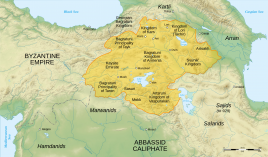Bagratid Armenia
Monday, January 16, 2023
The Bagratid Kingdom of Armenia, also known as Bagratid Armenia, was an independent Armenian state established by Ashot I Bagratuni of the Bagratuni dynasty in the early 880s following nearly two centuries of foreign domination of Greater Armenia under Arab Umayyad and Abbasid rule.
With each of the two contemporary powers in the region—the Abbasids and Byzantines—too preoccupied to concentrate their forces in subjugating the region, and with the dissipation of several of the Armenian nakharar noble families, Ashot succeeded in asserting himself as the leading figure of a movement to dislodge the Arabs from Armenia.
Ashot's prestige rose as both Byzantine and Arab leaders—eager to maintain a buffer state near their frontiers—courted him. The Abbasid Caliphate recognized Ashot as "prince of princes" in 862 and, later on, as king (in 884 or 885). The establishment of the Bagratuni kingdom later led to the founding of several other Armenian principalities and kingdoms: Taron, Vaspurakan, Kars, Khachen and Syunik. During the reign of Ashot III (952/53–77), Ani became the kingdom's capital and grew into a thriving economic and cultural center.
The first half of the 11th century saw the decline and eventual collapse of the kingdom. The Byzantine emperor Basil II (r. 976–1025) won a string of victories and annexed parts of southwestern Armenia; King Hovhannes-Smbat felt forced to cede his lands and in 1022 pledged that his kingdom would pass to the Byzantines following his death. However, after Hovhannes-Smbat's death in 1041, his successor, Gagik II, refused to hand over Ani and continued resistance until 1045, when his kingdom, plagued by internal and external threats, was finally taken by Byzantine forces.
Background
The weakening of the Sassanian Empire during the 7th century led to the rise of another regional power, the Muslim Arabs. The Umayyad Arabs had conquered vast swaths of territory in the Middle East and, turning north, began to periodically launch raids into Armenia territory in 640. Theodore Rshtuni, the Armenian Curopalates, signed a peace treaty with the Caliphate although the continuing war with the Arabs and Byzantines soon led to further destruction throughout Armenia. In 661, Armenian leaders agreed to submit under Muslim rule while the latter conceded to recognize Grigor Mamikonian from the powerful Mamikonian nakharar family as ishkhan (or prince) of Armenia. Known as "al-Arminiya" with its capital at Dvin, the province was headed by an ostikan, or governor.
However, Umayyad rule in Armenia grew in cruelty in the early 8th century. Revolts against the Arabs spread throughout Armenia until 705, when under the pretext of meeting for negotiations, the Arab ostikan of Nakhichevan massacred almost all of the Armenian nobility. The Arabs attempted to conciliate with the Armenians but the levying of higher taxes, impoverishment of the country due to a lack of regional trade, and the Umayyads' preference of the Bagratuni family over the Mamikonians (other notable families included the Artsruni, Kamsarakan, and Rshtuni) made this difficult to accomplish. Taking advantage of the overthrow of the Umayyads by the 'Abbasids, a second rebellion was conceived although it too was met with failure partly because of the frictional relationship between the Bagratuni and Mamikonian families. The rebellion's failure also resulted in the near disintegration of the Mamikonian house which lost most of the land it controlled (members of the Artstruni house were able to escape and settle in Vaspurakan).
A third and final rebellion, stemming from similar grievances as the second, was launched in 774 under the leadership of Mushegh Mamikonian and with the support of other nakharars. The Abbasid Arabs, however, marched into Armenia with an army of 30,000 men and decisively crushed the rebellion and its instigators at the battle of Bagrevand on April 24, 775, leaving a void for the sole largely intact family, the Bagratunis, to fill.
Rise of the Bagratids
The Bagratuni family had done its best to improve its relations with the Abbasid caliphs ever since they took power in 750. The Abbasids always treated the family's overtures with suspicion but by the early 770s, the Bagratunis had won them over and the relationship between the two drastically improved: the Bagratuni family members were soon viewed as leaders of the Armenians in the region. Following the end of the third rebellion, which the Bagratunis had wisely chosen not to participate in, and the dispersal of several of the princely houses, the family was left without any formidable rivals. Nevertheless, any immediate opportunities to take full control of the region was complicated by Arab immigration to Armenia and the caliph's appointment of emirs to rule in newly created administrative districts (emirates). But the number of Arabs residing in Armenia never grew in number to form a majority nor were the emirates fully subordinate to the Caliph. As historian George Bournoutian observes, "this fragmentation of Arab authority provided the opportunity for the resurgence" of the Bagratuni family headed by Ashot Msaker (the "Meat-Eater").
Ashot began to annex the lands that formerly belonged to the Mamikonians and actively campaigned against the emirs as a sign of his allegiance to the Caliphate, who in 804 bestowed upon him the title of ishkhan. Upon his death in 826, Ashot bequeathed his land to two of his sons: the eldest, Bagrat II Bagratuni received Taron and Sasun and inherited the prestigious title of ishkhanats ishkhan, or prince of princes, whereas his brother, Smbat the Confessor, became the sparapet of Sper and Tayk.
The brothers, however, were unable to resolve their differences with one another nor able to form a unified front against the Muslims. A new Armenian rebellion against Arab rule broke out in 850 led by Bagrat and Ashot Artsruni of Vaspurakan but like previous rebellions, it failed: an Arab army led by the Turkic general Bugha al-Kabir captured Bagrat, Smbat, and other Armenian princes and brutally put down the rebellion.





